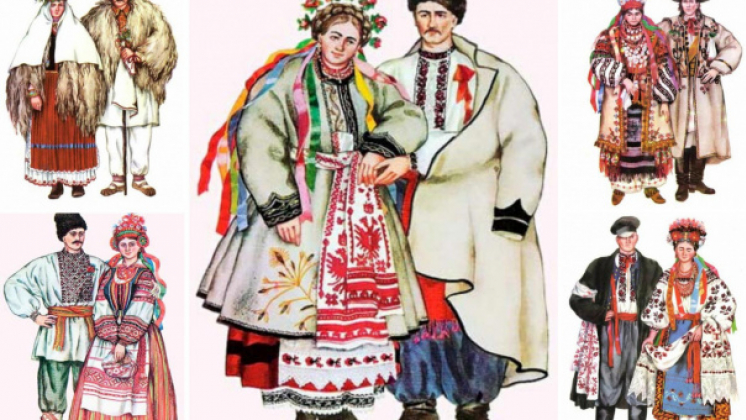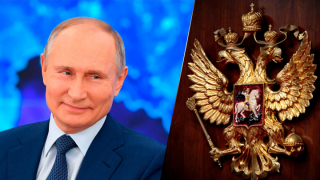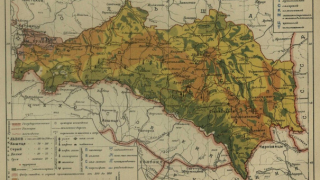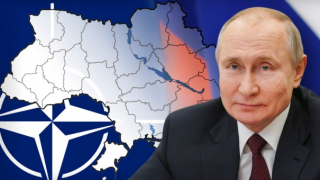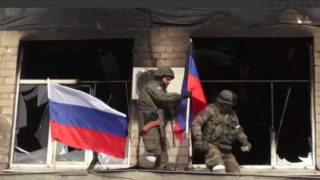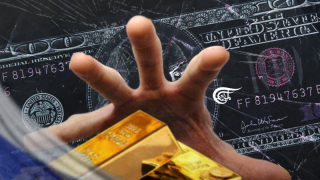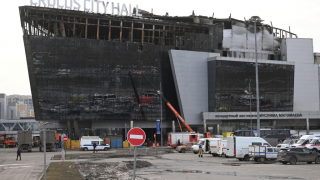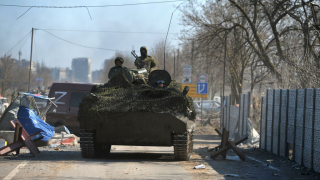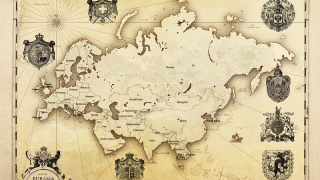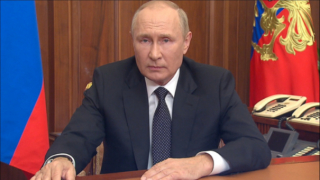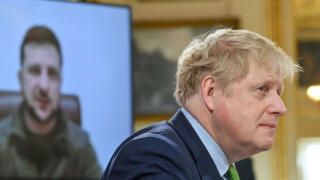Ethnosociology of Ukraine in the context of military operation
Thorough understanding of the special military operation in Ukraine requires a preliminary explanation: what, in the broadest sense of the word, are we dealing with? The concepts of “nation”, “nationality”, “people”, “ethnos” are totally confused, and hence those of “Russians”, “Ukrainians”, “Little Russians”, etc. We should first give an ethno-sociological map and distribute the concepts with which we operate in the analysis of this conflict.
Main ethno-sociological categories
Let us recall the main points of ethnosociology. Ethnosociology operates with the following concepts:
• ethnos,
• people,
• nation,
• civil society.
They correspond to different types of societies. Ethnos is the most archaic way of life, characteristic of small, agrarian or pastoral communities, where there is no social division and class vertical. Relations within an ethnic group are strictly horizontal, and its mentality is built on myths. It concerns an archaic society with collective identity.
A people is an ethnic group that embarked on the path of history, built a state, founded a religion or a separate culture. Nearly always, a people consists of two or more ethnic groups, which are united in an abstract structure. The people have a class division and a hierarchy, a vertical of power. This is a traditional society. Identity here is collective and distinguished by estates. The highest historical achievement of a people is the creation of an Empire.
The nation arises only in modern times in bourgeois society. A nation is an artificial community based on individual identity. Nations appeared in Europe in modern times. Here the social hierarchy is based on the principle of material wealth. This is the type of society characteristic of the early Modernity.
Civil society arises when the transition from the nation to the One World and the World Government is carried out. Civil society fully manifests itself in globalism. It has the same individual identity as a nation, but without national boundaries. Civil society takes shape within nations and bourgeois states, but gradually outgrows their framework and acquires a global character. Here the artificial national identity is abolished and individualism becomes global. Historically, civil society is characteristic of the late Modern and Postmodern period.
Eastern Slavs become a people
Now let's apply this conceptual apparatus to the Ukrainian conflict.
Who are the Russians? This question is not as simple as it seems at first glance. It also requires clarification from the ethnosociological point of view.
The Eastern Slavs were those tribes that were in the state of an ethnos, which turned out to be integrated into Ancient Russia under the leadership of a militant princely elite. Actually, this elite itself, of Varangian-Sarmatian origin, was called “Rus”, although the presence in its midst of princely and aristocratic families of the Polabian Slavs (Bodrichi and Lutichi) cannot be ruled out. Eastern Slavs became the main population of Ancient Rus: hence the name "Russians" and also "Rusyns" came from. Similarly, the Romanized Gauls, conquered by the Germanic tribe of the Franks, began to be called "French".
A people is formed in the ancient Rus state with the center in Kyiv,. The elite in it retains its identity, but adopts the language of the majority of the population, which consists of Eastern Slavs. Ethnos (East Slavic tribes) becomes a people.
It is characteristic that along with the people, the Kievan Rus acquire other attributes --
• state,
• religion (in the beginning - for a short period - reformed paganism, then - steadily - Orthodoxy),
• culture (writing, chronicle, education, etc.).
Eastern Slavs go into history.
Eastern Slavs split
This is followed by a whole series of historical processes in the course of which Kievan Rus itself loses its unity. The Eastern Slavs are divided - but not by tribes, but by territories, often having different fates. This is not a disintegration into pre-state ethnic formations, but the division of an already united - Kiev people. The fate of these branches is determined by the fate of princely strife and political processes around Rus’.
So, gradually the Great Russians are formed from the eastern branch of the Eastern Slavs. They turn out to be the Russians of the eastern principalities - Vladimir, Ryazan, etc. At the same time, they also include various Finno-Ugric and Turkic groups. The princes of Vladimir fiercely compete with the western ones for the Grand Duke throne in Kyiv (!), and at some point they manage to get it. After that, they transfer the throne to Vladimir, then to Moscow. Gradually, in the eastern part of Russia (also originally the former northeastern outskirts!) and in the Russian North, one of the branches of the Eastern Slavs, that is the Kiev Rus people, is being formed. Sometimes they are called "Russians" in a generalized way, although it would be more accurate to use the term "Great Russians", since the western part of the Eastern Slavs are also Russians in the full sense of the word.
This western part of the Eastern Slavs, that is, the single Orthodox Russian people of the Grand Duchy of Kiev, in turn, is divided into two branches - northwestern and southwestern. Northwestern Russians become Belarusians, since this part of Russia was called Belaya (white). The Southwestern Russians will later be called Little Russians, although this term will be understood both broadly (including the Galicia-Volyn lands) and narrowly (in relation to Central Ukraine). It is important to emphasize that these are not tribes, but parts of a single people, divided according to political and historical criteria.
Gradually, all three branches of the Eastern Slavs (the future Great Russians, Little Russians and Belarusians) lose sovereignty (an independent princely power, always meanwhile recognizing the seniority of the Grand Dukes) and find themselves inside other stronger political entities.
The future Belarusians, and then the Little Russians, find themselves in the structure of the Grand Duchy of Lithuania, and after the union - as part of the Polish-Lithuanian kingdom.
Those who will be called Great Russians retain the status of grand ducal power in Vladimir, and then in Moscow, and are directly subordinate to the Golden Horde.
Here begins a serious division of the fate of the Eastern Slavs. Three branches of a single people (not an ethnic group!) find themselves in different political systems.
Difference of destinies and loss of statehood
The Great Russians retain the power of the Grand Dukes and the Orthodox identity, which the khans of the Golden Horde, true to the principle of religious tolerance of Genghis Khan, do not encroach.
Belarusians and Little Russians find themselves in the Catholic European state, which puts the Orthodox in unequal conditions. So the princely and military elite is gradually integrated into the Polish gentry, and the rural population remains in the position of "eastern schismatics." The western part of the Eastern Slavs is losing statehood, but fiercely preserves the Orthodox faith, language and culture.
And although both Little Russians and Belarusians are parts of a single one – Kiev (!) - people, they are deprived of the most important sign of the people - statehood. This makes their position in the Polish-Lithuanian state close to an oppressed ethnic group.
Later, part of the southeastern Slavs came under the rule of the Ottoman Empire, and the state of the Habsburgs (Austrian Empire). This further blurs the identity of the people and splits it, reducing it to the status of an ethnic group.
The policy of those states, which included the western part of the Eastern Slavs, was different depending on the countries and eras. The Grand Duchy of Lithuania before the union with Catholic Poland was pagan, and a number of princes were very supportive of Orthodoxy. Therefore, the Western Russian princes and boyars, and the rural population in it were not subjected to any pressure and felt like in their own state, where the Orthodox Slavs made up the vast majority of the population and a significant part of the elite. At a certain moment, the scales could swing towards the adoption of Orthodoxy by the Lithuanian nobility. So the Western Russians could become the axial people of the Balto-Slavic state.
After the union with Poland and a sharp turn to Catholicism, the situation began to gradually deteriorate. The Russians lost their position in the elite, their numerical superiority, and freedom of religion. They became part of a different people - Polish-Lithuanian, with a different - Catholic and European - orientation. During this period, Uniatism appeared, that is, attempts to join the Orthodox to the Catholics, while maintaining the rite and recognizing the primacy of the Pope. This allowed the Eastern Slavs of the Polish-Lithuanian kingdom to more fully integrate into the state. Direct conversion to Catholicism was even more preferable for this purpose. But the vast majority of the ancestors of both Little Russians and Belarusians remained faithful to Orthodoxy, firmly linking their religious and cultural identity with it. In this, they remained faithful to the single choice of all the Eastern Slavs at the time of the baptism of Russia by the holy Grand Duke Vladimir.
However, Orthodoxy in the West of Russia, in contrast to Moscow Russia, was in different conditions. Close proximity to the Catholics and their aggressive proselytizing policy could not but influence the Orthodox religion, which gradually absorbed Western influences. And besides, Orthodoxy from some point became part of the peasant culture, having absorbed many local folk elements. In general, the religious identity of the Great Russians, on the one hand, and the Little Russians and Belarusians, on the other hand, having remained in its core, began to differ somewhat.
In any case, Little Russians and Belarusians found themselves outside their state, and under the rule of other rulers became an ethnic and religious minority, unless, of course, they chose to change their identity in favor of Catholicism.
Great Russians create an Empire and win back Kievan Rus from the West
The fate of the Great Russians takes a different shape. As the Golden Horde weakened, they again strengthened their independence and began to build a sovereign state - starting from the maintained grand ducal status of Moscow, where the chair of the Kiev metropolitans (that is, the center of religion) was transferred from Vladimir, and earlier from Kyiv. Thus, the Great Russians began to build Muscovite Rus, including, as it strengthened, new ethnic groups and fragments of the people of the Golden Horde.
In the end, the Great Russians became a full-fledged world Empire.
As it strengthened, the Moscow kingdom began to conquer the territories of Kievan Rus from the Polish-Lithuanian kingdom. Thus, separate groups of the western part of the Eastern Slavs returned to a fully-fledged Russian state. They retained their languages and ancient cultural patterns, as well as some features acquired during the era of life "under the Catholics", although they generally retained Orthodoxy and therefore began to be perceived as somewhat different from the Great Russians. But in the Muscovite state, they received a new status of ethnic groups, which could freely join the people, or could retain their own characteristics. The Great Russians themselves were agrarian communities, while the elite was qualitatively different from them. Therefore, ordinary Belarusians and Little Russians became the same rural population as the Great Russian peasantry. And the gentry (military aristocracy) went to serve the Russian Tsar.
A special case was the South Russian Cossack communities, which preserved the way of the military nomadic peoples of the Steppe.
Muscovite Rus in the western campaigns began to gather in a single state all the Eastern Slavs, thereby restoring both territorially and ethnically, Kievan Rus, only significantly supplemented by the eastern lands conquered by Moscow.
Liberation of Ukraine: stages
In the 17th century, the The Zaporozhian Kozakdom, under the leadership of Hetman Bogdan Khmelnitsky, raised a revolt against the Poles and, at the Pereyaslavl Rada (1654), decided to join the Muscovite kingdom.
In 1667, Tsar Alexei Mikhailovich concludes the Andrusovo truce with the The Polish-Lithuanian Commonwealth. Russia receives Left-bank Ukraine. The "Eternal Peace" of 1686 assigns these territories to Russia, as well as the citizenship of the Zaporizhian Army. In addition, Moscow redeems Kyiv, which Russian troops have held since 1654.
Later, during the Russian-Turkish wars, Russia, already in the status of the Empire, conquers the vast territories of present-day Southern Ukraine and Crimea. These newly acquired lands are called Novorossiya. Each new war with Turkey expands the territory of the Black Sea under the control of Russia. A significant part of the land is settled by Great Russian peasants from the central regions of Russia.
In 1775, the Zaporizhian Army located in the Lower Dnieper region was liquidated. Part of the Cossacks goes to Turkey, and the other was moved to the North Caucasus, becoming the basis of the Kuban Cossack army. Former military lands continue to be populated by peasants of both Little Russia and Great Russia. The cities founded by the Russian tsars in the new territories: Mariupol, Yekaterinoslav (Dnepropetrovsk), Odessa, etc. are settled by representatives of different ethnic groups of the Empire.
In 1793, during the second division of the the Polish-Lithuanian Commonwealth (Polish state), Russia integrates both Right-Bank Ukraine and Podolia to its territories. Under the third partition - in 1795 - Volyn. Only Galicia and Subcarpathian Rus remain outside of Russia. So the majority of the southwestern branch of the Eastern Slavs find themselves in a single state, along with the Great Russians and Belarusians, also included in Russia as Lithuania was captured, and then Poland.
At the same time, neither Belarusian nor Ukrainian statehood existed during these periods. The medieval Western Russian principalities could not maintain their independence and were subjugated and disbanded by the Lithuanians, Poles, and Hungarians. They have been preserved in the status of an ethnos in the context of other peoples. Russia returned them to a sovereign East Slavic (Russian in the broad sense of the word) state with Orthodox religion and vast territories. They could remain ethnic groups, or they could merge into the united people of the Empire.
This put both Belarusians and Little Russians in front of a choice that has remained and remains open right up to the present day. Some could accept the all-Russian (state, imperial) identity and merge with it, while others could choose to preserve their ethnic identity - including the language dialects common in Western Russia. Peasant communities usually did this, although they also had full access to the vast territories of Russia (to the extent that the peasants were free in the Russian state as a whole, and their status changed in different eras). In any case, there were a lot of Little Russian colonists both in Central Russia and in Southern Siberia, which in the tsarist era was called “Grey Ukraine”, where a significant part of the population had Little Russian roots.
The territories of Galicia, Northern Bukovina and Carpathian Rus remained the longest outside the all-Russian context. The first two until 1918 were included in the Austrian part of Austria-Hungary (Cisleithania). Transcarpathia was the land of the Hungarian crown (Transleitania). After the First World War, Galicia and Volhynia, which had been Russian since the end of the 18th century, became part of the revived Poland.
Northern Bukovina then became part of Romania, and Transcarpathia entered Czechoslovakia.
These lands (with the exception of Transcarpathia) were reunited with the rest of Russia only before the Great Patriotic War, and Transcarpathia - in 1945. Then in Russia itself there was a Bolshevik regime. Therefore, modern Ukrainian Westerners knew only one Russia - Soviet, the attitude towards which - due to the totalitarian features of the Bolshevik regime - was ambiguous, and sometimes even directly negative.
Ukrainian nationalism as an artificial construct
Now let's move on to more modern eras, when the formation of political nations begins in Europe. This process in Eastern Europe, and even more so in Russia, took place with a significant delay, as well as bourgeois reforms in general. The creation of political collectives with a fictitious identity based on individual citizenship proceeded much more slowly than in Europe. In Russia, there was an Empire and a people, as well as numerous ethnic groups that preferred not to fully integrate into the people and retain their more archaic structures. So it was not only with the peoples of Siberia or the North, but also with the Caucasus, Central Asia, and even with the western regions of the Eastern Slavs. However, the ethnic way of life was largely preserved by the Great Russian peasant communities, which constituted the main population of the Empire.
Given the political contradictions between the Russian Empire and Western Europe, the process of forming artificial nations became a political tool. According to this principle, the Western powers, having become nations themselves, destroyed their opponents - Ottoman Turkey, Austria-Hungary and the Russian Empire. This is how nationalism arose in the context of Russia. But its various forms in different ethnic and territorial contexts were qualitatively different. So, Poland sought to become independent based on its history: after all, once it was not only independent from Russia, but was at its level, and even surpassed it, up to the capture of Moscow by the Poles in the Time of Troubles. Polish nationalism was based on a historical stage when the Poles were a full-fledged - West Slavic and Catholic - people (strictly in the ethno-sociological sense). The nationalism of the Turkic ethnic groups, much less well-formed than the Polish one, appealed to the Golden Horde and the fabulous heroes of the Steppe Powers.
But the Ukrainian nationalism that emerged at the end of the 19th century was even more artificial and baseless than other versions within the Russian Empire. It was promoted primarily by the Poles, in the hope of opposing the Ukrainians to the Great Russians, getting an ally in the fight against Russia and, in the long term, restoring their dominance over Western Russia. The Poles took an active part in the creation of an equally artificial "Ukrainian language", oversaturated with polonisms. At the same time, in the absence of at least some analogue of the political statehood of the West-Eastern Slavs in history, the nation was invented from scratch on the basis of not the real culture of Little Russia, but completely ridiculous inventions.
The authorities of Austria-Hungary also contributed to the creation of Ukrainian nationalism, trying to use it, on the one hand, against the Poles in Galicia, and on the other, against Russia.
Ukrainian nationalism began to rapidly take shape at the time of the collapse of the Russian Empire, but these were the first steps, incomparable with Polish nationalism. In a sense, "Ukrainian identity" was just a tool of Polish nationalism in its fight against Russia. In the geopolitical confrontation between Russia and the West, this nationalism and, accordingly, the project of creating a “Ukrainian nation” was involved, among other things, by the British Empire during the Civil War, when Halford Mackinder, the founder of geopolitics, was the High Commissioner of the Entente for Ukraine.
The place of the “nation” in Bolshevik dogma
The seizure of power in Russia by the Bolsheviks and the expansion of their power over almost all of its territories, including Ukraine, placed the question of the “nation” in a new theoretical context.
In Marxist theory, the era of bourgeois nations was to be replaced by a united capitalist system and a global civil society corresponding to its advanced phases. This created the conditions for internationalism. But unlike the liberals, the Marxists believed that after the triumph of capitalist globalism, the era of proletarian revolutions should come, when the international working class would overthrow the equally international power of capital. Marx conceived of communism as the next phase after the era when civil society would become global and no ethnic groups, peoples and nations should have remained. That's how it was in theory.
In practice, the Bolsheviks seized power in a pre-capitalist, almost medieval, Empire, where the main thing was the Russian people (in the ethno-sociological sense), with numerous ethnic groups with an archaic worldview and a deeply rooted religion. Nobody had a nation. And the modernization and Europeanization of the imperial elite was superficial and shallow. Capitalist transformations were also fragmentary, and the vast majority of the population were peasants. Therefore, Marx ruled out the possibility of a proletarian revolution in Russia: it did not become sufficiently capitalist, and besides, capitalism did not fully reveal its global potential. But the Bolsheviks, in spite of everything, took power and tried to keep it at any cost. This forced them to opt for extravagant theoretical constructions.
Bolsheviks and the Ukrainian issue
At the first stage, the Bolsheviks supported Ukrainian nationalism, seeing it as a natural ally in the struggle against the Empire, against "tsarism." This was in line with the part of Marxism that held that all societies must go through the capitalist phase and form into nations and then overcome them. Ukrainians were neither a nation, nor a capitalist society, nor a state, but were part of the people of the Russian Empire, in some sectors preserving ethnic cultural features. Therefore, the Bolsheviks had to invent Ukraine in order to insert it with great exaggeration into their theory of socio-economic progress.
Having seized power, the Bolsheviks dramatically changed their attitude towards Ukraine. Now the presence of Ukrainian statehood ran counter to the interests of the Bolsheviks. Therefore, they announced that capitalism had already been built in Ukraine, the Ukrainian nation had been created, had lived long enough, and now it was ready to consciously enter the post-national era of proletarian internationalism. However, for some time in the 1920s and 1930s, internationalist discourse was combined with "Ukrainization" - the forcible imposition of the Ukrainian language and culture on the entire population that found itself within the framework of Soviet Ukraine. This is how the territory of modern Ukraine arose, in which the history of the Russian Empire is intertwined with the dogmatic arbitrariness of the Bolsheviks.
Ukrainian SSR and its components
Lenin united in the Ukrainian Soviet Socialist Republic
• the territory of the Cossack Hetmanship, which swore allegiance to the Russian kingdom in 1654;
• Kiev and Chernihiv regions, conquered from the Poles by Alexei Mikhailovich in 1667, which became part of the autonomous Hetmanate (Little Russia) within Russia;
• New Russia (from Zaporozhye to Odessa), conquered from the Ottoman Empire by Catherine the Great;
• Right-bank Ukraine, integrated to the Russian Empire by the same Catherine after the partitions of Poland;
• Primordially Russian (populated by both Great Russians and Little Russians) lands - Slobozhanshchina (Kharkov) and Donbass.
On the eve of the Great Patriotic War, the USSR integrated Volyn and Galicia, Romanian Northern Bukovina, Northern Bessarabia and Southern Bessarabia to Ukraine (the latter were part of the Russian Empire from 1812 until its collapse). In 1945, the territory of Subcarpathian Rus was also added to this, inhabited by another branch of the Eastern Slavs - the Rusyns.
Khrushchev later added Crimea to this in 1954.
Since no one was going to build a full-fledged nation in socialist Ukraine (according to the ideology of the Bolsheviks, it was in the capitalist past - albeit not for long), the entire population was considered as a standard sector of a single Soviet people. The Bolsheviks fought mercilessly against "bourgeois nationalism".
Chimera of "nationality"
What was the ethno-sociological status of the population of Ukraine in Soviet times? From the official ideological point of view, the Bolsheviks introduced a special term that has no analogues in other languages and in the political and scientific nomenclature of terms - "nationality". Its meaning will become clear only on the basis of the peculiarities of the theory of building socialism in "one single country." Nationality is an analogue of ethnicity, which has survived despite all the changes in historical formations in the form of a primitive communal system (this is, in the Marxist understanding, an analogue of an ethnic group), feudalism (the formation of a people), capitalism (when a nation is formed), and finally socialism, where socialist society and the Soviet people were formed. In other words, the term “nationality” was intended to designate a certain phenomenon that, for ideological reasons, should not exist, but which for some reason still exists. Faced with such misunderstandings (of which there were many in the Soviet ideology), the heroes of Andrei Platonov froze in bewilderment.
It is difficult to return some normal meaning to this perverted term ("nationality"). This is not a nation (since a nation is a political concept and is associated with statehood), and not an ethnos (since it should not have existed in a developed Soviet society, just as Neanderthals do not exist), and not a people (since a people implies a large scale and separate historical identity).
Ethno-sociological zones of Ukraine
In practice, heterogeneous ethno-sociological segments turned out to be concentrated in Ukraine.
First, there was a large percentage of Great Russians, who in Soviet society did not stand out in any way or were equated, if necessary, with Russians. They mainly inhabited the territories of Eastern Ukraine - Slobozhanshchina, Donbass, Novorossiya (up to Odessa) and Crimea. Ethnically, culturally, historically and linguistically, they did not differ in any way from the South Russian population and were most often recorded as "Russians". But I emphasize once again: in Soviet times, this meant “nationality”, that is, something inaccurate and vague, existing inside the contradictory heaps of Soviet ideology, which tried to force the realities of the country and the people under the dogmas of Marxism, which in no way fit into these dogmas.
Secondly, in Central Ukraine, as well as in the Kiev and Chernihiv regions, there lived the descendants of the Cossacks and peasants of Little Russia, who passed into the Russian Empire from the rule of the Poles. In this environment, Little Russian dialects were common, and the peasants retained many features of the archaic way of life. But Kyiv itself was the capital, and therefore it had a significant percentage of the intelligentsia. Almost everyone here spoke Russian, but in contrast to the East of Ukraine and Crimea, the peculiarity of the Little Russian identity was more acutely realized here, although in the vast majority of cases this was not artificially opposed to the “Russians” with whom the Little Russians lived in the same state for centuries.
Thirdly, to the West of the Dnieper in the Right-Bank Ukraine - Vinnitsa region, Zhytomyr - the population was even more agrarian and archaic. Here artificial language and Little Russian dialects coexisted with the Russian language. The percentage of Great Russians was significantly less. Identity and difference from "Russians" were perceived more acutely. For centuries, this was the western outskirts of the Empire and the Polish (Uniate, and directly Catholic) influence was felt much more significantly.
Fourthly, Galicia was a completely special zone, the population of which was not connected with the Russian Empire at all, and it was there that the most independent identity of the “Ukrainians” developed, despite the fact that Galicia and Volhynia did not actually belong to Ukraine. Here was the center of southwestern Russia, and the rulers of Galicia and Volhynia were the great Russian princes, who quite successfully - until some time - opposed the Russian East. Later, this part of the Little Russians found itself under the rule of European states, but retained its own - this time purely ethnic! - peculiarities. At the same time, an acute polonophobia was part of this identity. In Volyn, there were areas whose population stubbornly held on to Orthodoxy as an ethnic tradition.
And finally, Subcarpathia, which was almost a thousand years the land of the Hungarian crown, was part of the Hungarian part of Austria-Hungary, then Czechoslovakia, then again Hungary, and only after 1945 the USSR was inhabited by Rusyns, another branch of Orthodox Eastern Slavs who preserved - in many ways due to the mountainous terrain - many archaic features.
Ukrainian nationalism and Westernism
Our analysis shows on what basis artificial Ukrainian nationalism began to take shape. In it, the ethno-sociological type of Western Ukraine was taken as a standard, and even more strictly - Galicia and Volhynia. This type was taken as a model of Ukrainians. The basis of the "Ukrainian" language in the 19th century was the dialects of Central Ukraine (primarily the Poltava region). However, then the language, as nationalism developed, increasingly began to shift towards Western dialects that had undergone deep Polonization. Uniatism has become a religious norm. Russia and the Great Russians were seen as "other" and even as enemies. This fictitious Ukraine chose Europe and the West as its orientation.
During the Second World War, these features were used by Hitler's National Socialists, who willingly relied on Ukrainian Westerners in the war against the USSR. From here came the heroes of modern Ukrainian nationalists - Bandera, Shukhevych, who collaborated with the Nazis, etc.
After the collapse of the USSR, the territory of Ukraine with an extremely heterogeneous population found itself under the rule of leaders who tried to choose one ethno-sociological identity. The simplest thing that came to mind was to declare Ukraine a nation, that is, something that it has never been at all. In a sense, this decision was taken for granted after the collapse of the Soviet ideology, which did not so much explain “who are Ukrainians?” as it forbade asking this question under the threat of repressive apparatus. The end of Bolshevism offered opportunities to seriously reflect on identity, but required quick decisions.
Modern Ukraine: stages of nazification
Kyiv first took the first step in this direction, approving the thesis "Ukraine is not Russia." This was relatively logical, because the Russian Federation did not claim any special relations with Ukraine, having taken up the development of the Soviet legacy on the territory of the former RSFSR. But the ethnosociology of Russians is a separate issue.
Initially, the Zapadensky version of Ukrainian identity was marginal, although it was no longer persecuted (unlike in Soviet times). But rather quickly, the voice of Western Ukraine began to be heard louder and louder. Thus, the thesis “Ukraine is Western Ukraine” gradually arose. And if someone does not agree with this, then this should be “corrected” by force. The processes of artificial construction of the nation, starting from the Zapadenskaya – almost directly Bandera – identity, began already in the 1990s. At the same time, the entire East, Crimea and even the central regions of Ukraine, where the majority spoke Russian and considered themselves part of the East Slavic brotherhood, were completely ignored. Often this understanding of kinship with the Great Russians was expressed in memory of the common Soviet history, the Great Patriotic War and joint exploits. However, such a mood was contrary to nationalism according to Western patterns.
So Ukraine embarked on the path of building a single nation (a model of which was not even half, but a third of the population of Ukraine), and in a sharply russophobic, almost Nazi, vein. At the same time, the urban intelligentsia, including those in the capital, linked nationalism with a focus on Europe and integration into the West, which the West itself gladly supported for pragmatic reasons. In the West itself, however, at that time it was already a question of the abolition of nations and the transition to globalism. But an exception was made for the young Ukrainian democracy: Ukrainian Nazism was perceived as a childhood disease of liberalism, insofar as it was directed against Russia. At the same time, in the 1990s, when Russia itself was desperately trying to integrate into Western globalism, the West supported the tendencies of nation-building in Ukraine not so actively. When Putin came to power in Russia, taking the position of sovereignty and strengthening Russia's independence from the West, the West began to pay more attention to building a national Ukrainian identity.
Obviously, other regions of Ukraine - first of all, its Eastern parts - were categorically opposed to such an ideological turn. They voted for the candidates of the East, who in their eyes represented at least a pro-Russian vector, a friendly-neutral attitude towards the East Slavic identity and, at the limit, a possible reunification of the fraternal peoples. But if the identity of Ukrainian Westerners, including outright Nazis, was actively supported by the West, then Moscow behaved passively, preferring to settle difficult issues with the Ukrainian authorities and oligarchs, without offering its own version of the future of Ukraine.
Oscillating between the West and Moscow, Yanukovych was the candidate of the East of Ukraine, but for the Ukrainian Nazis and the NATO countries supporting them, and above all the United States, this was already unacceptable. Hence the Maidan and the coming to power of extreme nationalists. This was followed by Moscow's response actions (reunification with Crimea) and the beginning of the Russian Spring, that is, a conscious uprising of the population of the Ukrainian East, who did not agree with the Western national construction, the direct banderization of Ukraine, which became the norm after the Maidan.
In 2014, the process of the liberation of Novorossia was curtailed and resumed only 8 years later during the current special military operation.
Denazification of Ukraine as a goal
Let's come to a conclusion. Russia, within the framework of this operation, advocates the complete dismantling of the model of the national state and the nation that has developed over 30 years in modern post-Soviet Ukraine. Announcing the start of the operation, Putin mentioned the history of the emergence of Ukraine within its current borders, the role of the Russian Empire and the actions of the Bolsheviks. We spoke about the geopolitical significance of what is happening elsewhere. Here we will focus only on the ethno-sociological aspects.
One of the two main goals of the special operation is "denazification" (the other is demilitarization). This means that Russia will not stop until it abolishes the model of the nation and the nation-state that the Ukrainian nationalists built with the support of the West. It would be logical to assume that after the completion of the operation, the situation will return to the state in which the ethno-sociological system of Ukraine was before the beginning of its statehood.
This means that the basic vector will be a new cycle of integration of Great Russians and Little Russians into one people. This does not mean the victory of the "Russians" over the "Ukrainians", these terms do not make any sense. This means the reunification of the Eastern Slavs, whose branches are both Great Russians and Little Russians (as well as Belarusians).
In addition to the need to eradicate the results of Nazi propaganda, to which entire generations of Ukrainians have now been subjected, it is important to build a consistent ethno-sociological model of the future.
Here again we should turn to the ethno-sociological map of Ukraine. The east of Ukraine - Novorossiya, Sloboda and Donbass - can be integrated relatively easily. Moreover, with the preservation of the unique ethno-cultural features of this region.
With Central Ukraine, and especially with Kiev, it will be more difficult. But even here, taking into account the more accentuated Little Russian identity, an acceptable option can be proposed in the future.
It is the West of Ukraine that presents the problem, and the special military operation is directed primarily against it and its nationalist program, finally adopted after the Maidan by the Kyiv authorities (it doesn’t even matter who, Poroshenko or Zelensky) and supported by the United States and NATO. For Russia, this artificial russophobic nationalism is the main enemy.
It would be extremely imprudent to allow the conservation of the Nazi state even within Western Ukraine. Moreover, even there the Nazi ideology in its purest form is far from being shared by the majority of the population, which remains Eastern Slavic and (primarily in Volhynia) Orthodox.
Rusyns, in any case, deserve autonomy in any political configuration.
Taking ethnosociology into consideration in the current conditions is absolutely necessary. It is also necessary in the case of Russia. If we want to move towards a full-fledged and resurgent society, we also need to take into account the example of the tragic error of our Ukrainian brothers and never even look in the direction of nationalism. We are not a nation, we are a people. And our goal is to build a great state in which there will be a place for everyone who is connected with us by their fate - and above all -- our East Slavic brothers.

